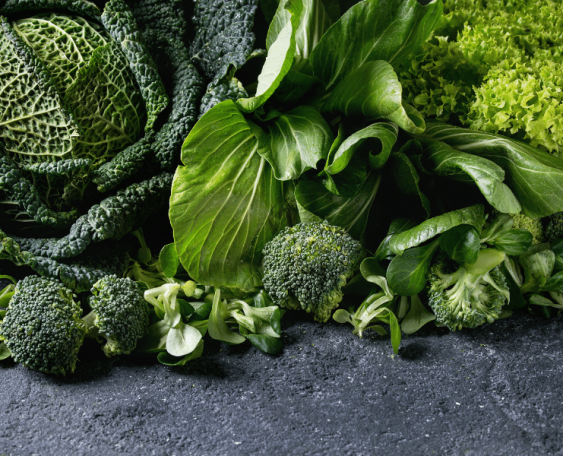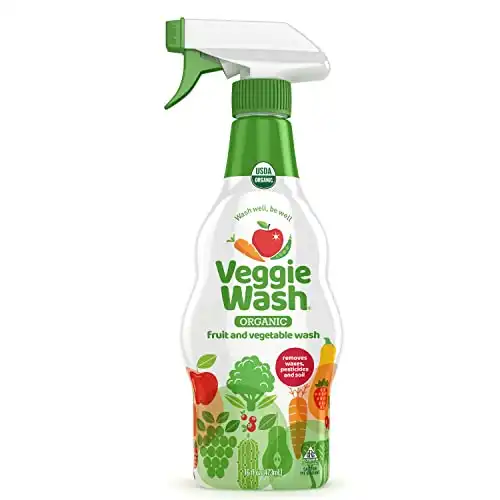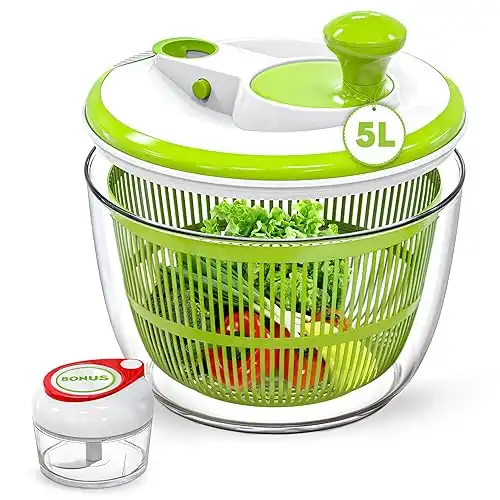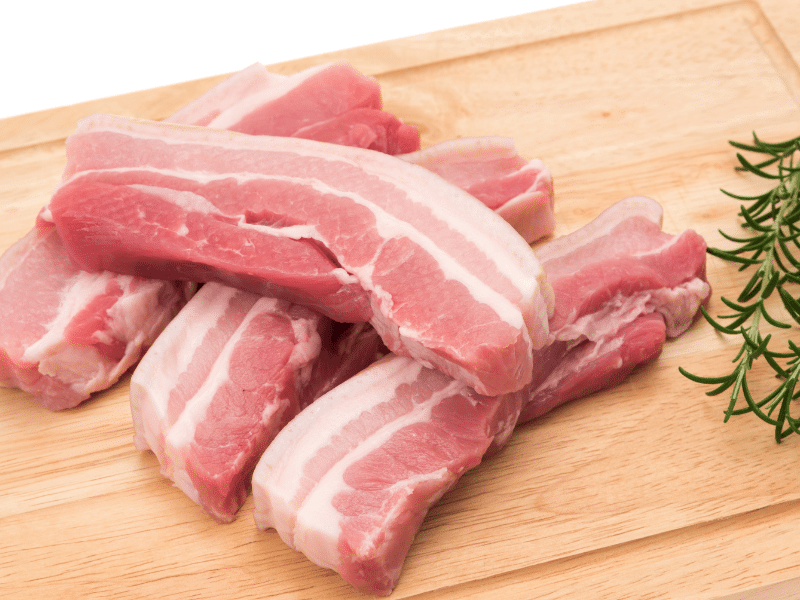While there are strict guidelines on food handling and preparation in the United States, leafy greens are a common culprit of food poisoning. Between 2014 and 2021, 78 foodborne illness outbreaks connected to lettuce and other leafy greens were reported to the Centers for Disease Control and Prevention.
What Makes Leafy Greens a Risk for Food Poisoning?
Unlike many foods, lettuce and other leafy greens are often consumed raw. Whether in a salad, on a sandwich, or as a garnish to a main course, leafy vegetables are a popular way to add color, texture, and flavor to dishes. However, raw foods are more likely to contain germs or pathogens invisible to the naked eye, which can make consumers sick.
Additionally, consider where the greens originate. Raw vegetables and other types of produce are often contaminated with germs found in the soil or water.
Consumer Reports adds that romaine lettuce is particularly at risk for contamination because of its delicate leaves. When leaves are broken or damaged, bacteria are more likely to get inside where they cannot be rinsed.
According to the CDC, washing leafy greens helps remove most harmful germs that can make you sick. However, no washing method will completely remove all germs.
Commonly Contaminated Leafy Greens
When you’re shopping at the grocery store or farmer’s market, it may not even occur to you that you could get food poisoning from lettuce or other vegetables. Unfortunately, many people become ill after consuming contaminated leafy greens.
Common types of leafy greens that carry some risk of foodborne illnesses include the following:
- Lettuce: Different types have been connected to multi-state E. coli outbreaks and multiple other outbreaks over the last few decades.
- Spinach: Spinach is another leafy vegetable that may contain harmful bacteria and germs, including E. coli, salmonella, and listeria.
- Kale: The National Library of Medicine listed kale as one of the leafy vegetables linked to high-profile outbreaks and severe illnesses.
- Cabbage: Viral and bacterial outbreaks have been connected to raw cabbage found in deli salads, including coleslaw.
- Arugula: Like other leafy greens, contaminated arugula can cause food poisoning from E. coli, salmonella, listeria, and other microbes.
- Lettuce Mix: Spring mixes or prepackaged salads may contain harmful germs that cause foodborne illnesses. Check the packaging to see if the greens are prewashed. If not, make sure you rinse mixed greens with water before eating.
Helps ensure your fruits and veggies are free of wax, dirt, and potential chemical residues.
Food Poisoning From Leafy Greens
Many consumers have questions about the safety of fresh produce, including leafy vegetables. Can bad spinach make you sick? What happens if you eat bad arugula? Can you get food poisoning from lettuce?
The truth is that eating raw foods increases the risk of developing a foodborne illness. There’s also a chance of developing food poisoning if food is not packaged, handled, or cooked properly.
Common types of bacteria, viruses, and microbes that contaminate leafy greens and cause food poisoning include:
- E. coli: While E. coli is naturally present in many foods, the harmful Shiga toxin-producing strains can cause diarrhea, stomach cramps, nausea, and other symptoms if ingested.
- Salmonella: If green, leafy vegetables are contaminated with salmonella, it can cause severe food poisoning symptoms, including diarrhea, vomiting, headache, fever, and muscle pain.
- Listeria: Another bacteria found on some leafy greens is listeria, which can grow and multiply even when refrigerated. Food poisoning from listeria can cause flu-like symptoms, such as fever, vomiting, diarrhea, and muscle aches.
- Norovirus: Between 1998 and 2012, norovirus caused about 29 percent of foodborne illness outbreaks linked to leafy greens. People who eat food contaminated with norovirus often experience diarrhea, fever, abdominal cramps, fatigue, and dehydration.
- Cyclospora: Cyclospora is a single-celled parasite found in water or food contaminated with human fecal matter. It is often linked to produce imported from countries with hot or tropical climates.
- Shigella: Shigella is a bacteria that can cause severe gastroenteritis with as little as 200 cells. This bacteria causes Shigellosis, which accounts for about 1.4 percent of all foodborne illnesses in the United States.
How Does Food Poisoning in Leafy Greens Happen?
Leafy greens can get contaminated with dangerous bacteria, parasites, viruses, and other germs at any point from farming and harvest through preparation. Vegetables are sometimes grown on farms where cattle or other animals are nearby. Rain runoff or improper irrigation can lead to animal waste contaminating leafy green crops.
Sometimes, packaging facilities fail to maintain a clean environment and introduce germs during processing. Produce transported to distribution plants or stores can also become contaminated if the vehicle is not at the right temperature or food handlers do not follow safe practices.
Current data show leafy vegetable contamination can come from:
- Cattle waste
- Bacteria from irrigation canals
- Contaminated water
- Improper packing or shipping
- Food handler’s unwashed hands
- Unsanitary kitchens or food preparation areas
- Improper storage practices
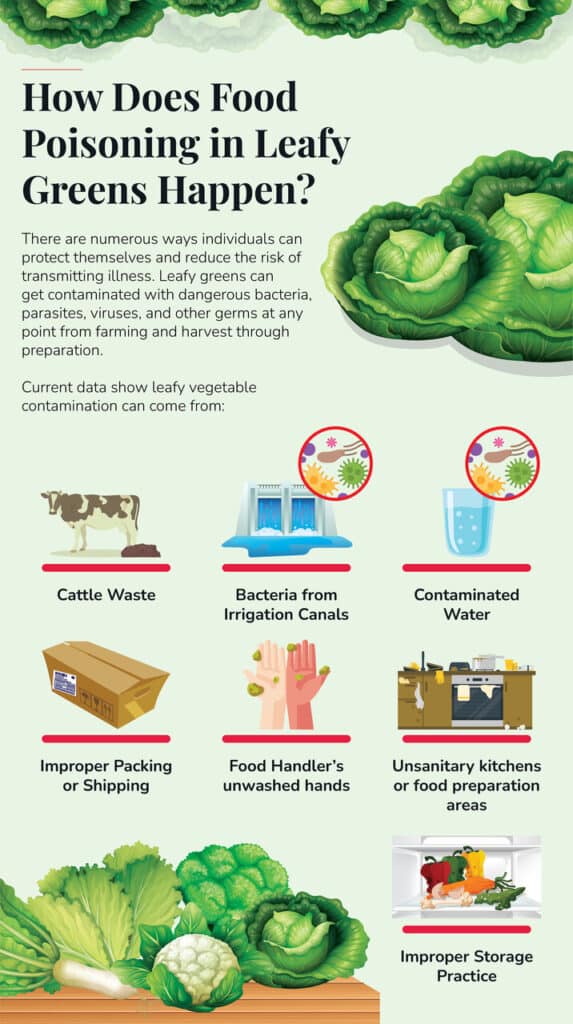
Food Safety Practices With Leafy Greens
The CDC provides the following tips for individuals on handling leafy greens and preventing food poisoning from these types of vegetables:
- Wash leafy greens by rinsing them under running water.
- Do not use disinfectants or produce-washing solutions to clean leafy greens.
- Do not soak leafy greens in water to clean them. This will only transfer contaminants from one leaf to another.
- Always store leafy greens in the refrigerator at 40° Fahrenheit or cooler.
- Cut leafy greens on a separate cutting board from meat, poultry, or seafood.
- Do not consume recalled leafy greens. Dispose of them immediately and disinfect all touched surfaces.
- Wash your hands before and after handling raw leafy greens.
Washing your produce is a crucial step, ensuring a clean and safe eating experience.
Because leafy greens are generally delicate, you don’t want to store them too long in the refrigerator. They can quickly become wilted and damaged, allowing bacteria to enter and multiply. Check dates, follow the guidelines provided on the product’s packaging, and discard any spoiled or damaged produce.
What Can Businesses Do To Prevent Leafy Greens Food Poisoning?
Restaurants, hotels, and other food-service businesses must follow all food safety guidelines when handling and preparing leafy greens. Management can also build relationships with their suppliers to understand more about the packaging, shipping, and delivery processes and how they affect the product’s quality.
It’s also essential to educate staff members on safe practices, including:
- Handwashing
- Food storage
- Food preparation
- Correct cleaning techniques
- Correct attire
Leafy Green Food Poisoning Outbreaks
Between 2014 and 2021, the CDC reported 2,028 illnesses, 477 hospitalizations, and 18 deaths connected to contaminated leafy greens. There also have been several recent foodborne illness outbreaks and recalls involving leafy greens, including the following incidents:
- December 2023: Spinach recall due to possible listeria exposure
- June 2023: Listeria outbreak from leafy greens
- August 2023: A new strain of E. coli found in lettuce
- October 2022: E. coli outbreak possibly connected to romaine lettuce at Wendy’s restaurants
- April 2022: E. coli O157:H7 infection outbreak from bagged romaine lettuce
- January 2022: E. coli outbreak linked to baby spinach
Negligence and Leafy Greens Food Poisoning
If you believe you or a loved one developed food poisoning from leafy greens due to negligence, Keep Food Safe can help.
Contact us to learn more about your rights and if you qualify to take legal action against negligent food handlers or distributors.

